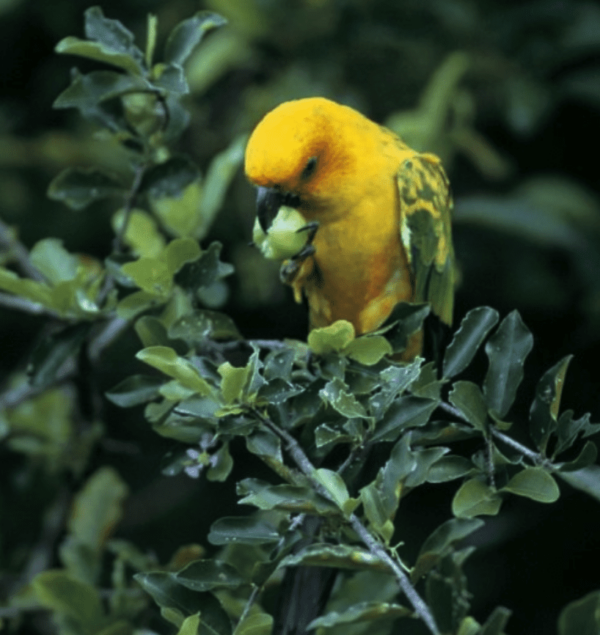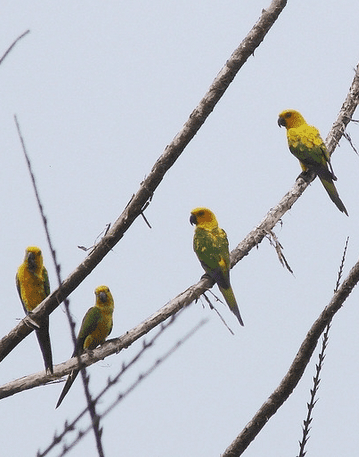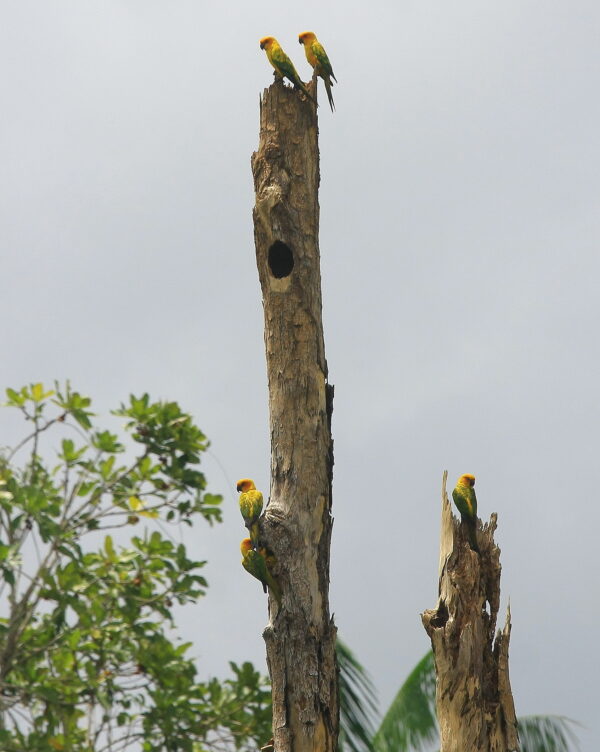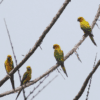Sulphur-breasted Conure
Also known as:
Sulphur-breasted Parakeet
Also known as:
Sulphur-breasted Parakeet

Aratinga

maculata
Size:
30 cm (11.7 in)
Weight:
120-130 g (4.2-4.5 oz)
Subspecies including nominate:
one
Colour Adult:
Both adults in general pale orange, with pale yellow-green head and hind neck, throat and breast pale yellow, thighs greenish, flanks pale orange, under-tail coverts greenish, mantle pale yellow-green, back pale yellow, rump pale yellow-orange, tail green-blue, wing green-yellow, under-wing coverts pale yellow. Narrow stripe of orange on forecrown and lores and around eyes. Eye ring light grey. Eye dark grey/brown. Beak nearly black.
Colour Juvenile:
Presumably as in adult but with cheeks and upper breast olive-yellow. (Observed from one specimen).
Call:
Calls made in flight are screechy and rapidly repeated in short notes. While perched emits chuckling and thin, high-pitched wheezy notes.
More Information:
Content Sources:
CITES
BirdLife International
Cornell Lab of Ornithology/Birds of the World
Parrots: A Guide to Parrots of the World, Juniper and Parr, 1998
Parrots of the World, Forshaw and Cooper, 1977.
Parrots of the World, Forshaw, 2006. 2010 edition
Psittacine Aviculture, Schubot, Clubb and Clubb, 1992.
A Guide to Incubation and Handraising Parrots, Digney, 1998.
Captive Status:
Virtually unknown; kept by local people and zoos in Brazil.
Longevity:
Up to 30 yrs.
Housing:
Aviary or suspended enclosure, minimum length 2-3 m (6.5-9.8 ft).
Diet:
Fruit such as: apple, pear, orange, banana, pomegranate, cactus fruits; vegetables such as: carrot, celery, green beans and peas in the pod; fresh corn; green leaves such as: Swiss chard, lettuce, sowthistle, chickweed; spray millet; small seed mix such as: canary, millet and smaller amounts of oats, buckwheat and safflower; soaked and sprouted sunflower seed; cooked beans or pulses, boiled maize, and complete kibble.
Enrichment:
Socialization. Also enjoys bathing, so provide overhead misters or shallow water bowls. Provide bird-safe wood and vegetable tanned leather chew toys, non-toxic hard plastic toys, puzzle toys, foraging toys, ladders, swings and different sized perches.
Nest Box Size:
Vertical box 12″ x 12″ x 18″ (30.5 cm x 30.5 cm x 46 cm).
Clutch Size:
3-4
Fledging Age:
7-8 weeks
Hatch Weight:
—
Peak Weight:
—
Weaning Weight:
—
World Population:
Unknown, increasing.
IUCN Red List Status:
Least Concern
CITES Listing:
Appendix II
Threat Summary:
Fairly common at Monte Alegre, Brazil, where for now there is no strong trapping pressure. May benefit from deforestation by expanding its range into recently cleared areas, however, over time ongoing forest loss may become so extensive that the species could start to decline.
Range:
NE Brazil in northern Para, and lower Rio Canuma in NE Amazonas.
Habitat:
Found in open, sandy areas with scattered small trees and bushes.
Wild Diet:
Feeds on fruits and seeds of Guateria sp., Dalechampia sp., Byrsonima sp. and Myrcia sp.
Ecology and Behaviour:
Is similar in behaviour and general ecology to the species of the Aratinga solstitalis group. Found in groups of 2-10 birds and are relatively tame, feeding alongside roads and in orchards.
Clutch and Egg Size:
One nest observed with one egg; size unknown.
Breeding Season:
August-October. Nest is in tree cavity.




![© Roger Le Guen [CC BY 2.0] via Flickr A wild Sulphur-breasted Conure feeds on fruit](https://parrots.org/wp-content/uploads/2023/01/Wild-Sulphur-breasted-Conure-e1730842890870-100x100.png)
![© Carol Peroni [CC BY-SA 2.0] via Flickr A Sulphur-breasted Conure clings to the side of a cage](https://parrots.org/wp-content/uploads/2023/01/wpt_Sulphur-breasted-Conure_1786-2-100x100.jpg)

![© Fredrico Pereira [CC BY-NC-SA 2.0] via Flickr Wild Sulphur-breasted Conures perch on various snags](https://parrots.org/wp-content/uploads/1990/12/Sulphur-breasted-Conure-lg-100x100.jpg)